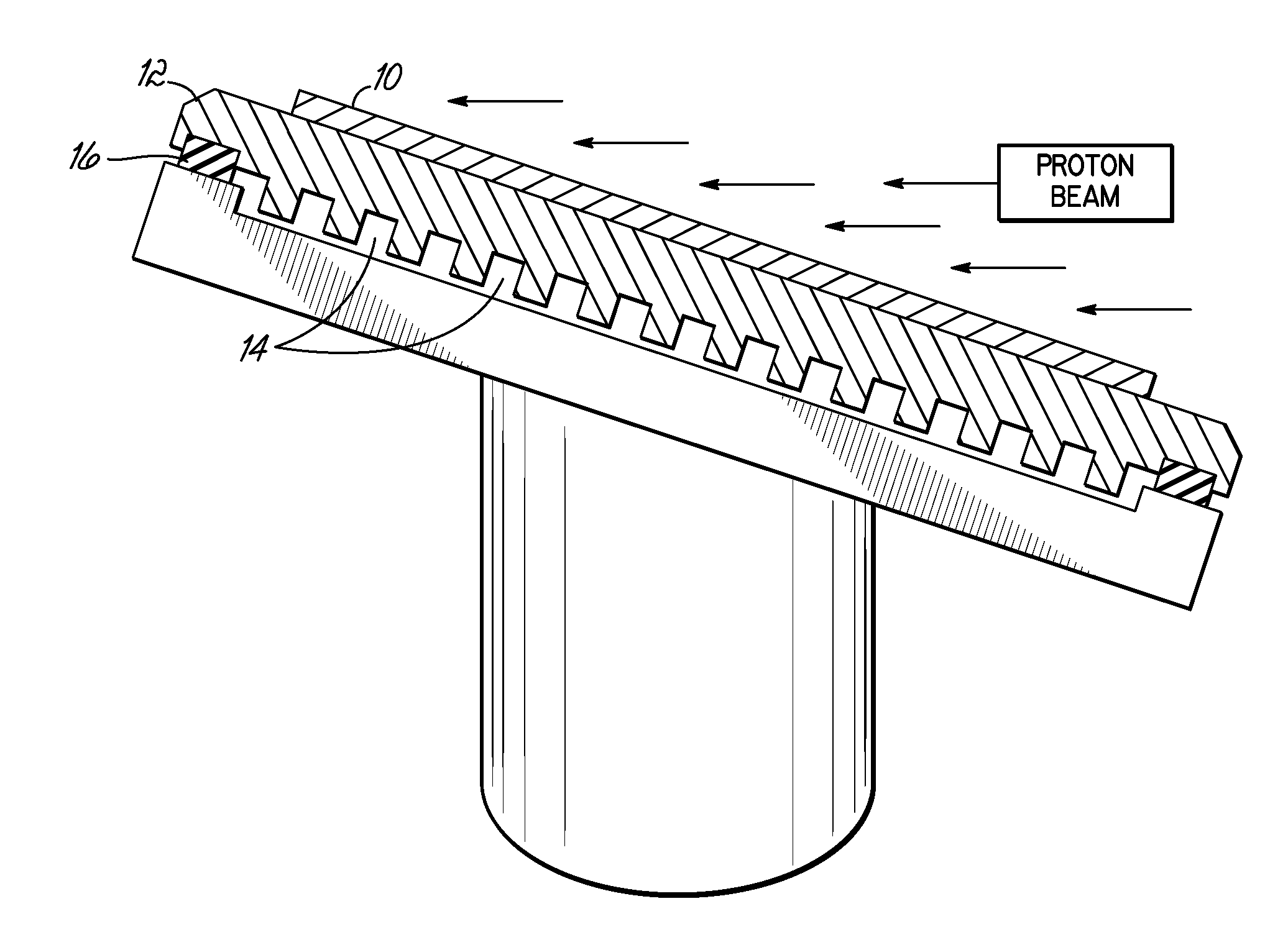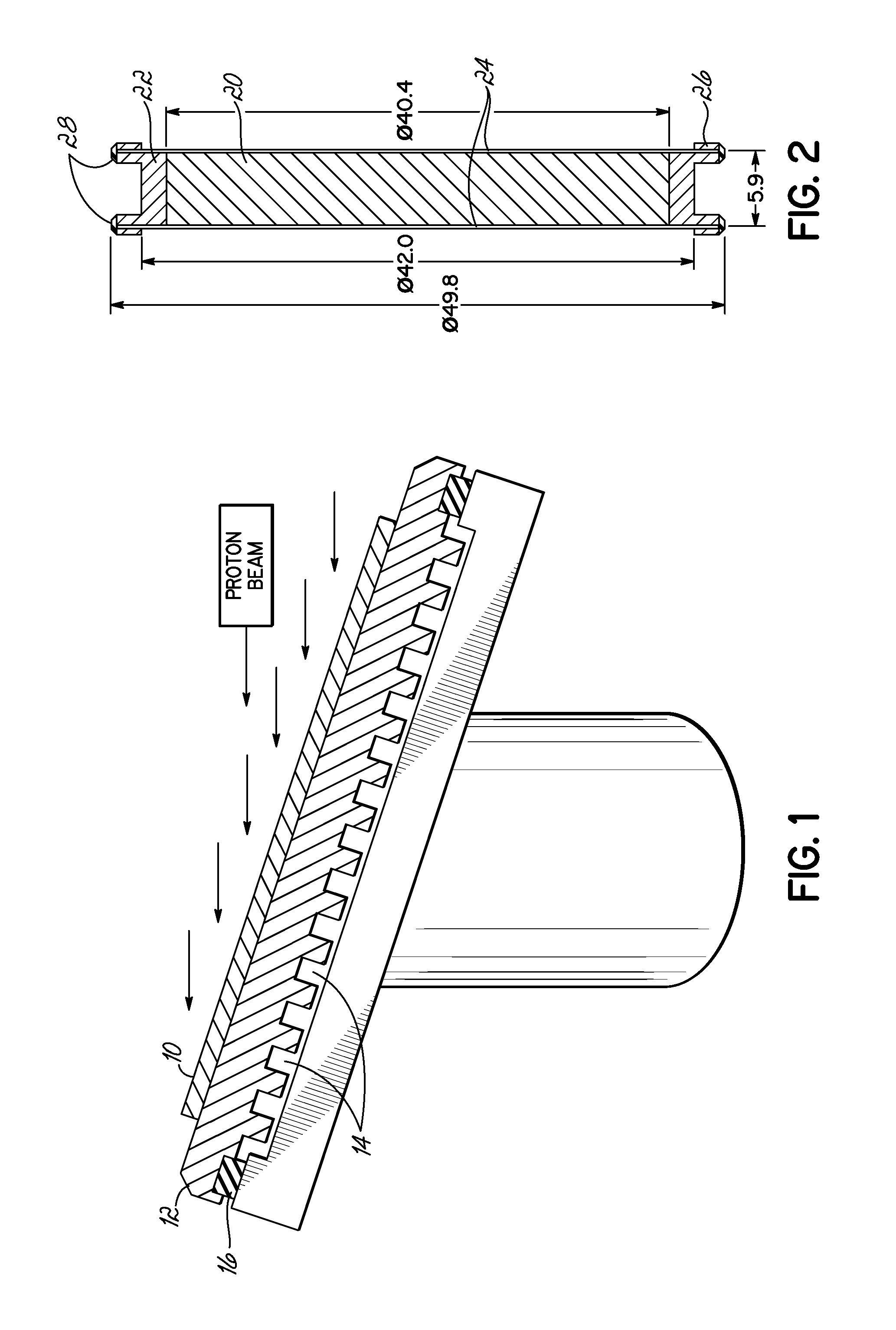Targets and methods for target preparation for radionuclide production
a radionuclide and target technology, applied in the field of nuclear technology, can solve the problems of low heat conductivity and thermal stability of pure sb, and the destruction of the target shell
- Summary
- Abstract
- Description
- Claims
- Application Information
AI Technical Summary
Problems solved by technology
Method used
Image
Examples
example 1
[0031]A plate of a copper alloy containing 62 atomic % Sb (76% in weight) thickness 0.4 mm was welded by means of diffusion welding to a copper backing block, as shown in FIG. 1. The diffusion welding was performed at unit pressure 100 kG / cm and temperature 400° C. (melting pressure of the alloy is 526° C.). The copper block from the back side had channels for cooling water; the water velocity was 4 m / s. The target was oriented to the beam at an angle of 11°. The target was irradiated by a proton beam having an energy range of 40-26 MeV, a beam current of 500 μA, and a beam spot area was of 12 cm2. Energy release in the target material was 580 W / cm2, and the maximum calculated temperature on the target surface was 350° C. The production rate of 117mSn was 3.2 mCi / h.
example 2
[0032]A round plate of Ti—Sb composition, containing 44 atomic % Sb (67% in weight), thickness 2.2 mm, diameter 45 mm was electroplated with nickel (layer thickness is 40 μm). The target cooled in all sides by water flow was irradiated with a proton beam (beam angle was 26°) with a beam current of 100 μA in the energy range 55-30 MeV. The production rate of 117mSn on the target material containing natural Sb was 2.3 mCi / h. There were no considerable admixtures of 113Sn. Using enriched 123Sb material in a similar target, the production rate was 3.6 mCi / h.
example 3
[0033]A ring plate of TiSb composition 5.8 mm thick inside titanium body ring (outer diameter is 50 mm, inner diameter is 40 mm), as shown in FIG. 2, was covered from the both sides by titanium (100 μm) and then nickel (50 μm) foils. The foils were welded to the plate by means of diffusion welding in vacuum under press 5200-5500 kG at 850° C. during 25 min. When the temperature was 600-650° C. the titanium foil was welded well to the titanium body ring but not to the TiSb composition. The obtained detail was additionally enhanced with 0.5 mm titanium rings and welded around by electron beam for a better sealing.
[0034]The resulting target was irradiated on proton beam (at angle 26°) in energy range 120-85 MeV with beam current 100 μA and the target was cooled from all sides by water flow. The production rate of 117mSn was 20 mCi / h. Considerable amounts of 113Sn were also produced in this target.
PUM
| Property | Measurement | Unit |
|---|---|---|
| temperature | aaaaa | aaaaa |
| temperature | aaaaa | aaaaa |
| thickness | aaaaa | aaaaa |
Abstract
Description
Claims
Application Information
 Login to View More
Login to View More - R&D
- Intellectual Property
- Life Sciences
- Materials
- Tech Scout
- Unparalleled Data Quality
- Higher Quality Content
- 60% Fewer Hallucinations
Browse by: Latest US Patents, China's latest patents, Technical Efficacy Thesaurus, Application Domain, Technology Topic, Popular Technical Reports.
© 2025 PatSnap. All rights reserved.Legal|Privacy policy|Modern Slavery Act Transparency Statement|Sitemap|About US| Contact US: help@patsnap.com


